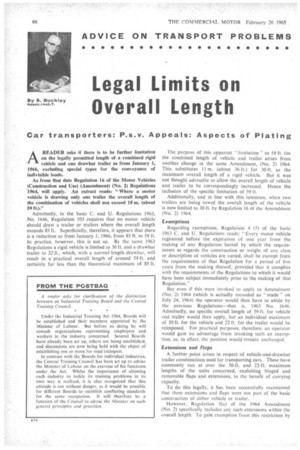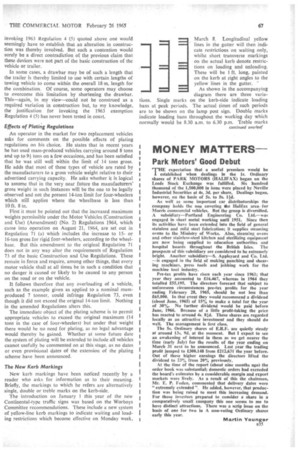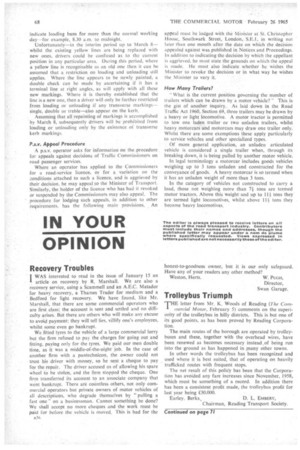Legal Limits on Overall Length
Page 68

Page 69

Page 70

If you've noticed an error in this article please click here to report it so we can fix it.
A. READER asks if there is to be further limitation on the legally permitted length of a combined rigid vehicle and one drawbar trailer as from January 1, 1966, excluding special types for the conveyance of indivisible loads.
As from that date Regulation 16 of the Motor Vehicles (Construction and Use) (Amendment) (No. 2) Regulations '1964, will apply. An extract reads: "Where a motor vehicle is drawing only one trailer the overall length of the combination of vehicles shall not exceed 18 m. (about 59 ft.)."
Admittedly, in the basic C. and U. Regulations 1963, No. 1646, Regulation 103 requires that no motor vehicle should draw a trailer or trailers where the overall length exceeds 85 ft. Superficially, therefore, it appears that there is a reduction as from January 1, 1966, from 85 ft. to 59 ft. In practice, however, this is not so. By the same 1963 Regulations a rigid vehicle is limited to 30 ft. and a drawbar trailer to 22 ft., which, with a normal-length drawbar, will result in a practical overall length of around 59 ft. and certainly far less than the theoretical maximum of 85 ft. The purpose of this apparent "limitation" to 59 ft. for the combined length of vehicle and trailer arises from another change in the same Amendment, (No. 2) 1964. This substitutes 11 m, (about 36 ft.) for 30 ft. as the maximum overall length of a rigid vehicle. But it was not thought advisable to allow the overall length of vehicle and trailer to be correspondingly increased. Hence the inclusion Of the specific limitation of 59 ft.
Additionally, and in line with this intention, when two trailers are being towed the overall length of the vehicle is now limited to 30 ft. by Regulation 16 of the Amendment (No. 2) 1964.
Exemptions
Regarding exemptions, Regulation 4 (5) of the basic 1963 C. and U. Regulations reads: "Every motor vehicle registered before the expiration of one year from the making of any Regulation hereof by which the requirements as regards the construction or weight of any class or description of vehicles are varied, shall be exempt from the requirements of that Regulation for a period of five years from the making thereof, provided that it complies with the requirements of the Regulations to which it would have been subject immediately prior to the making of that Regulation."
But even if this were invoked to apply to Amendment (No. 2) 1964 (which is actually recorded as " made " on July 24, 1964) the operator would then have to abide by the previous Regulations—that is, 1963 No, 1646. Admittedly, no specific overall lengthof 59 ft. for vehicle and trailer would then apply, but an individual maximum of 30 ft. for the vehicle and 22 ft. for the trailer would he reimposed. For practical purposes, therefore, an operator would gain no advantage from invoking such an exemption, as, in effect, the position would remain unchanged.
Extensions and Raps
A further point arises in respect of vehicle-and-drawbar trailer combinations used for transporting cars. These have commonly run at over the 30-ft. and 22-ft. maximum lengths of the units concerned, exploiting hinged and removable flaps and extensions, to the benefit of carrying capacity.
To do this legally, it has been successfully maintained that these extensions and flaps were not part of the basic construction a either vehicle or trailer.
However, Regulation 3(a) of the 1964 Amendment (No. 2) specifically includes any such extensions within the overall length. To gain exemption from this restriction by
invoking 1963 Regulation 4 (5) quoted above one would seemingly have to establish that an alteration in construction was thereby involved. But such a contention would surely be a direct contradiction of the previous claim that these devices were not part of the basic construction of the vehicle or trailer.
In some cases, a drawbar may be of such a length that the trailer is thereby limited to use with certain lengths of towing vehicle to come within the overall 18 m. length for the combination. Of course, some operators may choose to overcome this limitation by shortening the drawbar. This—again, in my view—could not be construed as a required variation in construction but, to my knowledge, the justification for invoking the 1963 exemption Regulation 4 (5) has never been tested in court.
Effects of Plating Regulations An operator in the market for two replacement vehicles asks for comments on the possible effects of plating regulations on his choice. He states that in recent years he has used mass-produced vehicles carrying around 8 tons and up to 91 tons on a few occasions, and has been satisfied that he was still well within the limit of 14 tons gross. He adds that most of these types of vehicle are rated by the manufacturers to a gross vehicle weight relative to their advertised carrying capacity. He asks whether it is logical to assume that in the very near future the manufacturers' gross weight in such instances will he the one to be legally observed and not the present 14-ton limit for four-wheelers which still applies where the wheelbase is less than 10 ft. 8 in.
First it must be pointed out that the increased maximum weights permissible under the Motor Vehicles (Construction and Use) (Amendment) (No. 2) Regulations 1964, which came into operation on August 21, 1964, are set out in Regulation 71 (a) which includes the increase to 15or 16-ton gross for rigid four-wheelers, according to the wheelbase. But this amendment to the original Regulation 71 does not in any way alter the requirements of Regulation 73 of the basic Construction and Use Regulations. These remain in force and require, among other things, that every motor vehicle shall at all times be in such a condition that no danger is caused or likely to be caused to any person on the road or on the vehicle.
It follows therefore that any overloading of a vehicle, such as the example given as applied to a nominal massproduced 7 tonner, could infringe Regulation 73, even though it did not exceed the original 14-ton limit. Nothing in the amended Regulations alters this.
The immediate object of the plating scheme is to permit appropriate vehicles to exceed the original maximum (14 tons in the case of four-wheelers) but under that weight there would be no need for plating, as no legal advantage would thereby be gained. Whether at some future date the system of plating will be extended to include all vehicles cannot usefully be commented on at this stage, as no dates or even provisional dates of the extension of the plating scheme have been announced.
The New Kerb Markings New kerb markings have been noticed recently by a reader who asks for information as to their meaning. Briefly, the markings to which he refers are alternatively single, double or treble marks on the kerb-side.
The introduction on January 1 this year of the new Continental-type traffic signs was based on the Worboys Committee recommendations. These include a new system of yellow-line kerb markings to indicate waiting and loading restrictions which become effective on Monday week, March 8. Longitudinal yellow lines in the gutter will then indicate restrictions on waiting only, whilst short transverse markings on the actual kerb denote restrictions on loading and unloading. These will be 1 ft. tong, painted on the kerb at right angles to the yellow lines in the gutter.
As shown in the accompanying diagram there are three varia on the kerb-side indicate loading . The actual times of such periods the lamp post sign. Double marks throughout the working day which 30 a.m. to 6.30 p.m. Treble marks
continued overleaf
MONEY MATTERS
Park Motors' Good Debut
THE expectation that a useful premium would he I established when dealings in the Is. Ordinary shares of PARK MOTORS (HALIFAX) began on the Leeds Stock Exchange was fulfilled. Six hundred thousand of the 1,500,000 in issue were placed by Neville Industrial Securities at 4s. 3d. per share. Dealings began, however, on the basis of 5s. to 5s. lid.
As well as some important car distributorships the company holds the one covering the Halifax area. for Morris commercial vehicles. But the group is diversified. A subsidiary—Portland Engineering Co. Ltd.—was engaged in sheet metal working until 1951. Since then its activities have been extended into the field of general stainless and mild steel fabrication; it supplies steaming ovens to the Ministry of Works. Also, steaming ovens and other stainless-steel kitchen and sterilizing equipment are now being supplied to education authorities and hospital boards throughout the British Isles. The prospects of this subsidiary are considered to be extremely bright. Another subsidiary—S. Appleyard and Co. Ltd. —is engaged in the field of making punching and shearing machines, press tools and jobbing work for the machine tool industry.
Pre-tax profits have risen each year since 1961; that year they amounted to £16,467, whereas in 1964 they totalled £55,195. The directors forecast that subject to unforeseen circumstances pre-tax profits for the year ending February 28, 1965, should be not less than 165,000. In that event they would recommend a dividend (about June, 1965) of 15% to make a total for the year of 30%. No further dividend would be paid before June, 1966. Because of a little profit-taking the price has reacted to around 4s. Sf d. These shares are regarded locally as an attractive investment and they should do well. The management is first class.
The 5s. Ordinary shares of E.R.F. are quietly steady at around 13s. 9d. at the moment. But I expect to see an awakening of interest in them as we get nearer the time (early July) for the results of the year ending on March 31 next to be announced. Last year the trading profit jumped to £300,148 from £212,631 the year before. Out of these higher earnings the directors lifted the dividend to 23% from 20% previously.
At the time of the report (about nine months ago) the order book was substantial; domestic orders had exceeded the board's estimates by a considerable margin and export markets were lively. As a result of this the chairman, Mr. E. P. Foden, commented that delivery dates were "extremely extended ". He added, however, that production was being raised to meet this increasing demand. For those investors prepared to consider a share in a comparatively small company this one seems to me to have distinct attractions. There was a scrip issue on the basis of one for two in A non-voting Ordinary shares early this year.
indicate loading bans for more than the normal working day—for example, 8.30 a.m, to midnight Unfortunately—in the interim period up to March 8— whilst the existing yellow lines are being replaced with new ones, drivers could be confused as to the current position in any particular area. During this period, where a yellow line is recognisable as an old one then it can be assumed that a restriction on loading and unloading still applies. Where the line appears to be newly painted, a double check can be made by ascertaining if it has a terminal line at right angles, as will apply with all these new markings. Where it is thereby established that the tine is a new one, then a driver will only be further restricted from loading or unloading if any transverse markings— single, double or treble—also appear on the kerb.
Assuming that all repainting of markings is accomplished by March 8, subsequently drivers will be prohibited from loading or unloading only by the existence of transverse kerb markings.
P.s.v. Appeal .Procedure
A p.s.v. operator asks for information on the .procedure fcir appeals against decisions of Traffic Commissioners on road passenger services.
Where an operator has applied to the Commissioners for a road-service licence, or for a variation on the conditions attached to such a licence, and is aggrieved by their decision, he may appeal to the Minister of Transport. Similarly, the holder of the licence who has had it revoked or suspended by the Commissioners may also appeal. The procedure for lodging such appeals, in addition to other requirements. has the following main provisions. An appeal' must he lodged with the Minister at St. Christopher House, Southwark Street, London,..S.E.L in writing not later than one month after the date on which the decision appealed against was published in Notices and Proceedings. In addition to indicating the decision bY which the appellant is aggrieved, he must state the grounds on which the appeal is made, He must also indicate whether he wishes the Minister to revoke the decision or in what way he wishes the Minister to vary it.
How Many Trailers?
"What is the current position governing the number of trailers which can be drawn by a motor vehicle? This is the gist of another inquiry. As -laid down in the Road Traffic Act 1960, Section 69, three trailers may be drawn by a heavy or light locomotive. A motor tractor is permitted to tow one laden trailer or two unladen trailers, whilst heavy motorcars and motorcars may draw one trailer only. Whilst there are some exemptions these apply particularly to service vehicles and other specialized types.
Of more general application, an unladen articulated vehicle is considered a single trailer when, through its breaking down, it is being pulled by another motor vehicle.
In legal terminology a motorcar includes goods vehicles weighing up to 3 tons unladen and constructed for the conveyance of goods. A heavy motorcar is so termed when it has an unladen weight of more than 3 tons.
In the category of vehicles not constructed to carry a load, those not weighing more than 11 tons are termed motor tractors. Above this weight and up to 111 tons they are termed light locomotives, whilst above 111 tons they become heavy locomotives.




















































































































